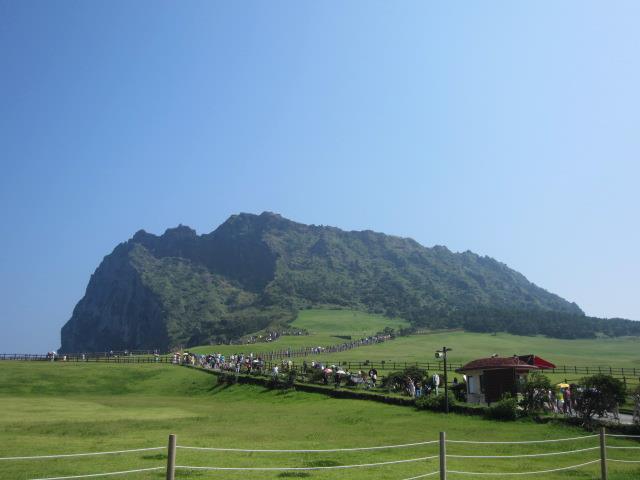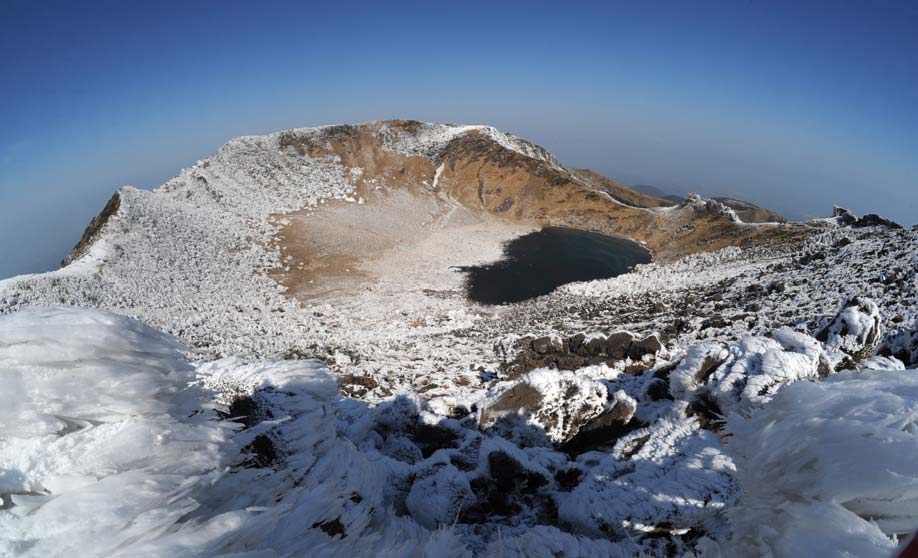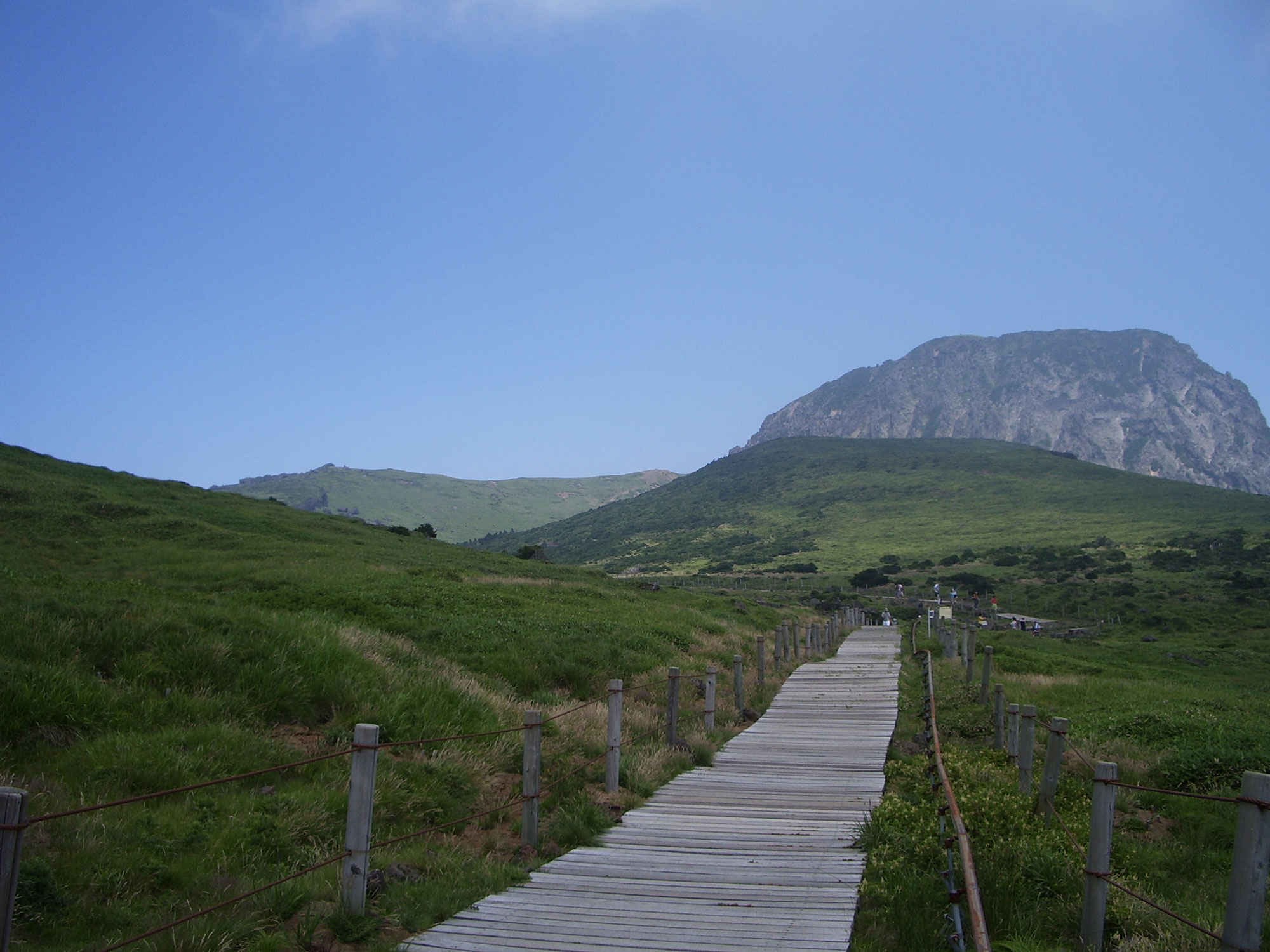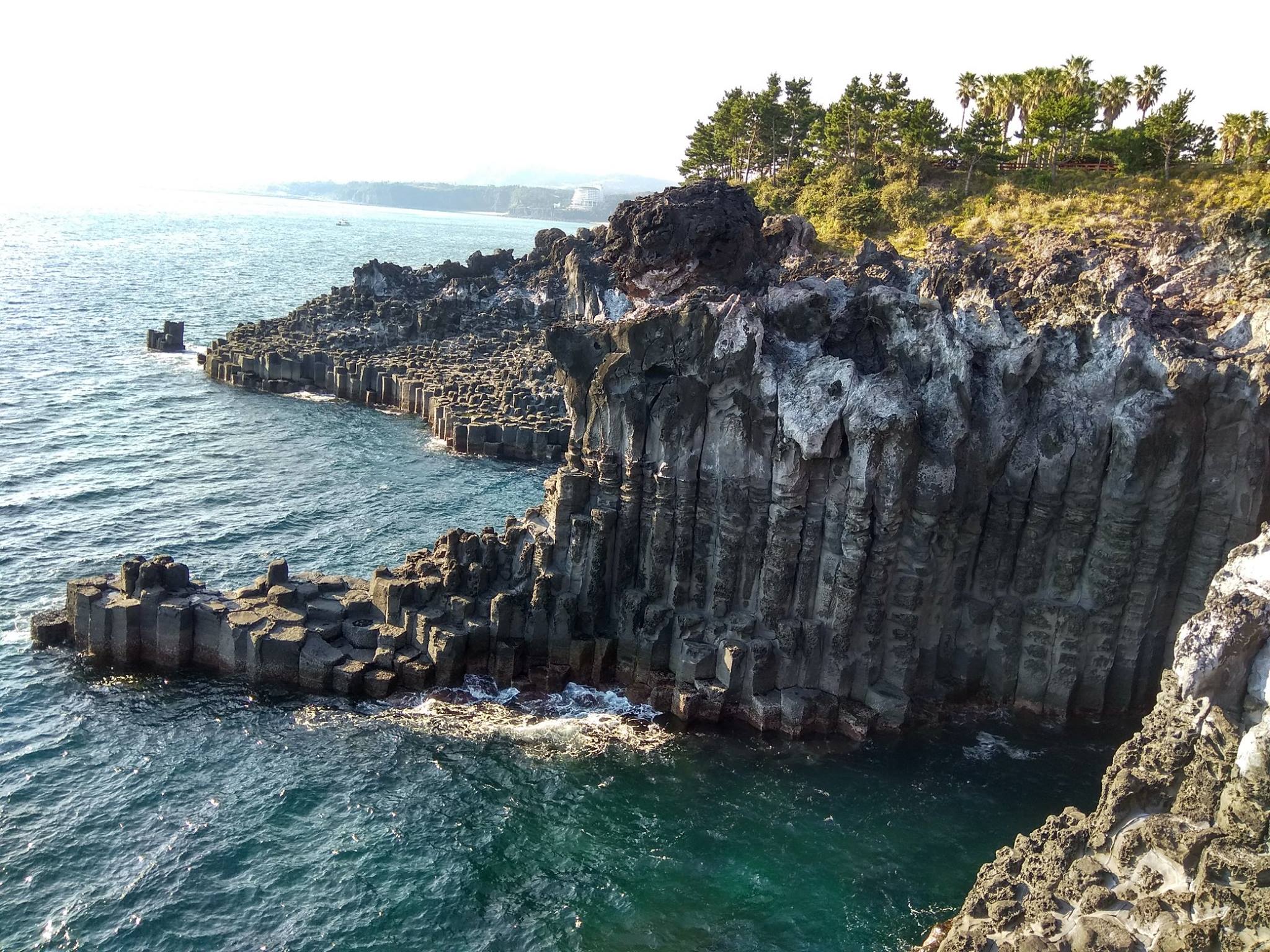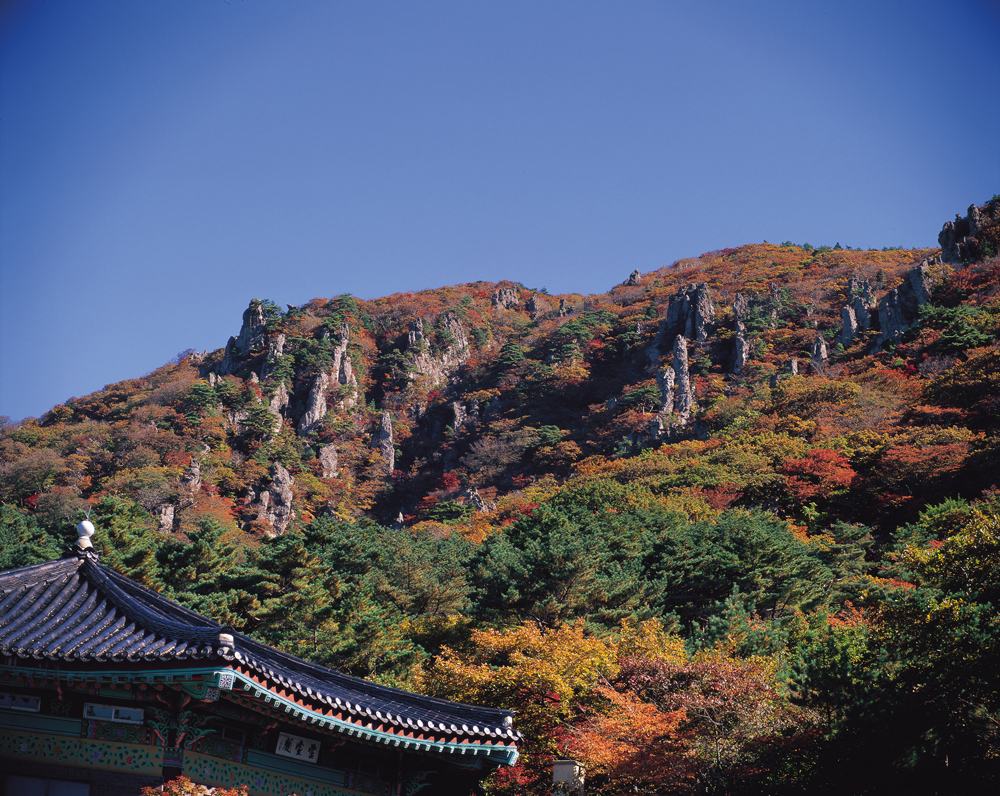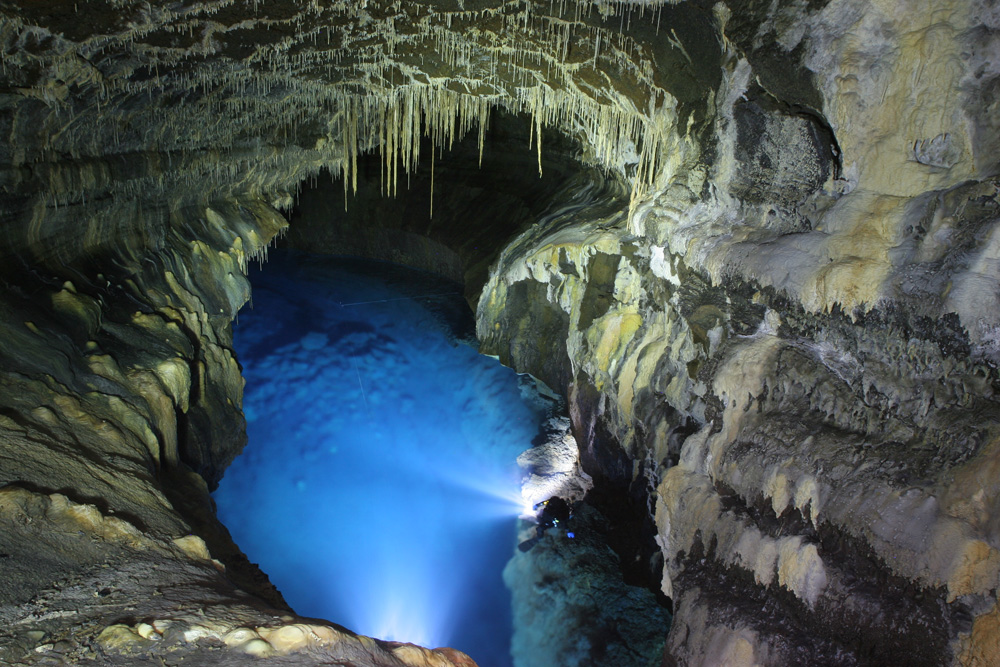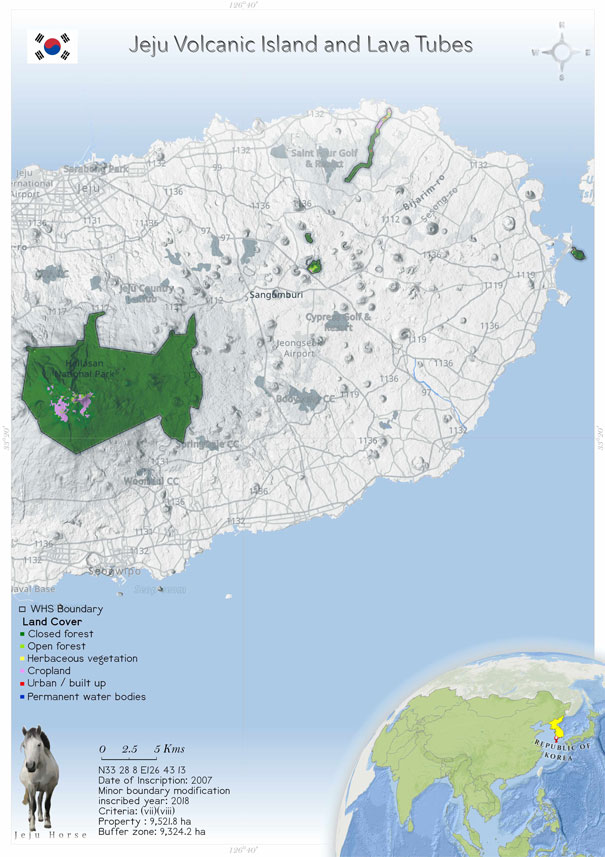
Jeju Volcanic Island and Lava Tubes (1264)
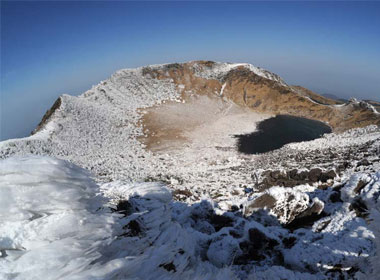 Jeju Volcanic Island is located at the southern tip of the Korean Peninsula, in the Korea Strait. The island appears elliptical as it stretches 75 km east–west and 32 km north–south. The site of a large number of volcanic eruptions, Jeju Island is primarily composed of granite, tuff and sedimentary rocks. Mount Halla (1950 m) is the largest volcanic mountain, located at the centre of the island, having produced more than 300 volcanic cones spread across the island. The three major components of Jeju Volcanic Island are (1) Hallasan Nature Reserve, (2) Seongsan Ichulbong (an eroded tuff cone) and (3) the Geomunoreum Lava Tube System. Speleothems made of carbon and calcite are a distinctive feature of the Geomunoreum Lava Tube System. The island's endemic small mammals include the Jeju shrew, Asian lesser white-toothed shrew, greater horseshoe bat, Japanese pipistrelle (Pipistrellus abramus), Alashanian pipistrelle, Jeju weasel and Siberian chipmunk. The site has remained well-protected by its rough terrain, volcanic structure and intertwined cave systems. However, there have been certain concerns about the World Heritage Property, including the groundwater in the island, which is decreasing alarmingly. Secondly, tourism (visitors from all over the world) has increased significantly, which has destroyed some crucial elements of the caves and biodiversity. Lastly, there is the issue of introduction of alien plant species and a specific turtle species, which is threatening the local biodiversity of Jeju Island.
Jeju Volcanic Island is located at the southern tip of the Korean Peninsula, in the Korea Strait. The island appears elliptical as it stretches 75 km east–west and 32 km north–south. The site of a large number of volcanic eruptions, Jeju Island is primarily composed of granite, tuff and sedimentary rocks. Mount Halla (1950 m) is the largest volcanic mountain, located at the centre of the island, having produced more than 300 volcanic cones spread across the island. The three major components of Jeju Volcanic Island are (1) Hallasan Nature Reserve, (2) Seongsan Ichulbong (an eroded tuff cone) and (3) the Geomunoreum Lava Tube System. Speleothems made of carbon and calcite are a distinctive feature of the Geomunoreum Lava Tube System. The island's endemic small mammals include the Jeju shrew, Asian lesser white-toothed shrew, greater horseshoe bat, Japanese pipistrelle (Pipistrellus abramus), Alashanian pipistrelle, Jeju weasel and Siberian chipmunk. The site has remained well-protected by its rough terrain, volcanic structure and intertwined cave systems. However, there have been certain concerns about the World Heritage Property, including the groundwater in the island, which is decreasing alarmingly. Secondly, tourism (visitors from all over the world) has increased significantly, which has destroyed some crucial elements of the caves and biodiversity. Lastly, there is the issue of introduction of alien plant species and a specific turtle species, which is threatening the local biodiversity of Jeju Island.
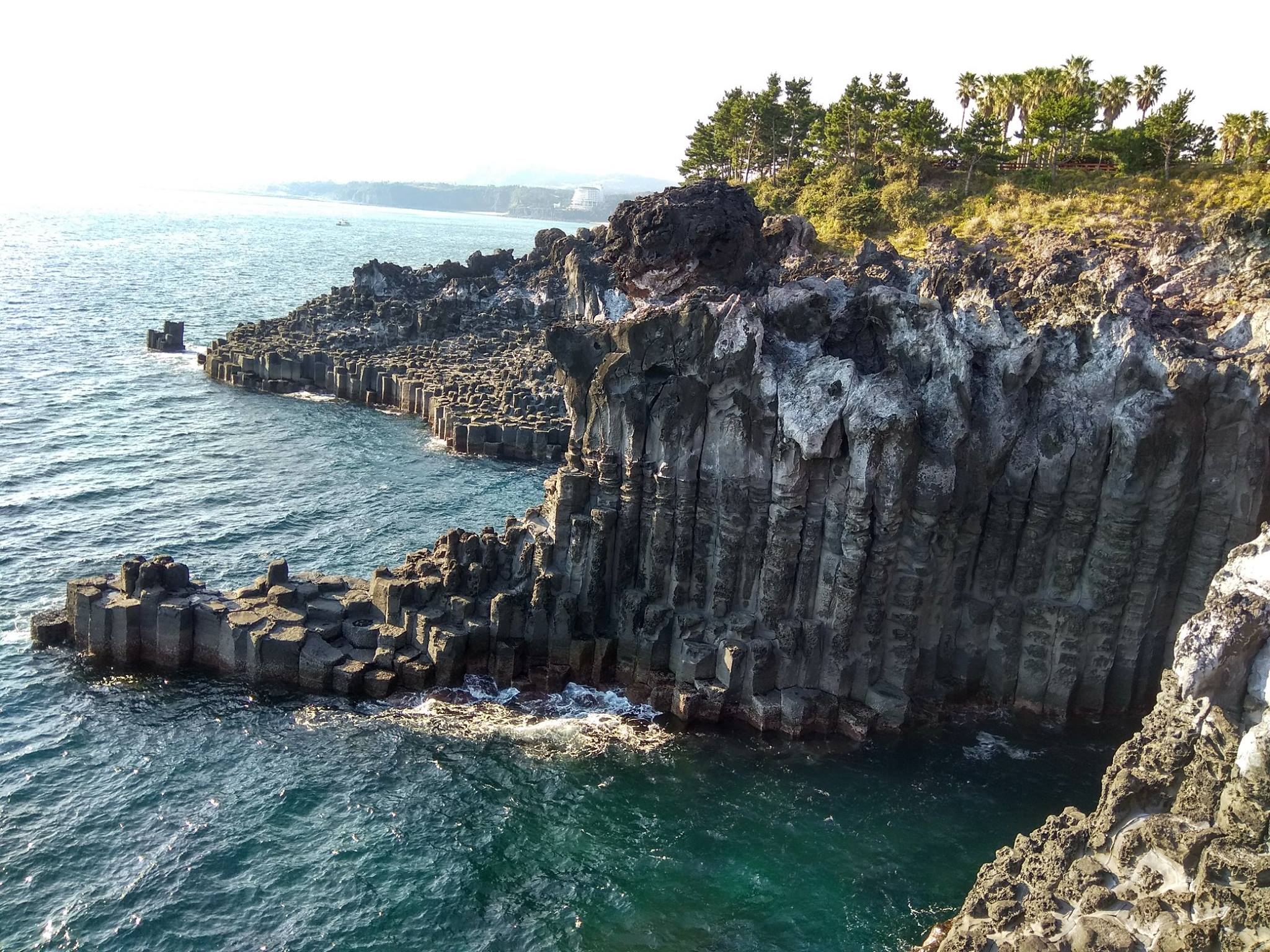 The Republic of Korea is well known for its rich culture and many well-preserved exquisite geomorphological features, natural landscapes and unique biodiversity. One of these landscapes is Jeju Volcanic Island. With its lava tubes, it was given the title of World Heritage Site by UNESCO in 2007. Geographically, Jeju Volcanic Island is situated at 33.509720°N, 126.521940°E. The island is long and elliptical in shape, stretching 75 km east–west and 32 km north–south (Song et al. 2018). The site is located on the continental shelf, off the south coast of the Korean Peninsula (Brenna et al. 2012). Several volcanic eruptions that occurred over 100,000 to 300,000 years ago led to the formation of Mount Halla, which stands at an altitude of 1950 m above sea level (Won et al. 2005). This World Heritage Property comprises three unique and distinct sub-regions: Mount Halla and Hallasan National Park, Geomunoreum Lava Tube system and Seongsan Ilchulbong Tuff Cone. Hallasan National Park is a protected area designated for its biodiversity, and Central Jeju was declared a biosphere reserve in 2002 (World Heritage Datasheet 2007; UNESCO whc.unesco.org).
The flora and fauna are also remarkable for displaying characteristic endemism. Most of the plants are found only in and around Hallasan National Park. A study conducted in 2006 led to the discovery of over 1990 species of plant (Kim et al. 2006). Reports have provided information on the presence of over 801 medicinal plant species in many parts of Jeju Island (Kim 2004). A study of the mammal diversity of Jeju island found several species of small mammal. These include the Jeju shrew (Sorex caecutiens hallamontanus), the Asian lesser white-toothed shrew (Crocidura shantungensis), the Greater horseshoe bat (Rhinolophus ferrumequinum quelpartis), the Japanese pipistrelle (Pipistrellus abramus), the Alashanian pipistrelle (Hypsugo alaschanicus coreensis), Myotis spp., the Jeju weasel (Mustela sibirica quelpartis), the Siberian chipmunk (Tamias sibiricus) and the greater long-tailed hamster (Tscherskia triton) (Jo et al. 2012). However, up to the early 20th century, Jeju Island was home to many larger mammals such as the leopard cat (Prionailurus bengalensis), brown bear (Ursus arctos), wild boar (Sus scrofa) and sika deer (Cervus nippon). Due to harsh circumstances, these species underwent local extinction. The island was also colonized by some invasive mammals such as Sciurus vulgaris, Tamias sibiricus and Myocastor coypus, which were introduced through human activities such as farming and intentional release (Jo et al. 2012).
The Republic of Korea is well known for its rich culture and many well-preserved exquisite geomorphological features, natural landscapes and unique biodiversity. One of these landscapes is Jeju Volcanic Island. With its lava tubes, it was given the title of World Heritage Site by UNESCO in 2007. Geographically, Jeju Volcanic Island is situated at 33.509720°N, 126.521940°E. The island is long and elliptical in shape, stretching 75 km east–west and 32 km north–south (Song et al. 2018). The site is located on the continental shelf, off the south coast of the Korean Peninsula (Brenna et al. 2012). Several volcanic eruptions that occurred over 100,000 to 300,000 years ago led to the formation of Mount Halla, which stands at an altitude of 1950 m above sea level (Won et al. 2005). This World Heritage Property comprises three unique and distinct sub-regions: Mount Halla and Hallasan National Park, Geomunoreum Lava Tube system and Seongsan Ilchulbong Tuff Cone. Hallasan National Park is a protected area designated for its biodiversity, and Central Jeju was declared a biosphere reserve in 2002 (World Heritage Datasheet 2007; UNESCO whc.unesco.org).
The flora and fauna are also remarkable for displaying characteristic endemism. Most of the plants are found only in and around Hallasan National Park. A study conducted in 2006 led to the discovery of over 1990 species of plant (Kim et al. 2006). Reports have provided information on the presence of over 801 medicinal plant species in many parts of Jeju Island (Kim 2004). A study of the mammal diversity of Jeju island found several species of small mammal. These include the Jeju shrew (Sorex caecutiens hallamontanus), the Asian lesser white-toothed shrew (Crocidura shantungensis), the Greater horseshoe bat (Rhinolophus ferrumequinum quelpartis), the Japanese pipistrelle (Pipistrellus abramus), the Alashanian pipistrelle (Hypsugo alaschanicus coreensis), Myotis spp., the Jeju weasel (Mustela sibirica quelpartis), the Siberian chipmunk (Tamias sibiricus) and the greater long-tailed hamster (Tscherskia triton) (Jo et al. 2012). However, up to the early 20th century, Jeju Island was home to many larger mammals such as the leopard cat (Prionailurus bengalensis), brown bear (Ursus arctos), wild boar (Sus scrofa) and sika deer (Cervus nippon). Due to harsh circumstances, these species underwent local extinction. The island was also colonized by some invasive mammals such as Sciurus vulgaris, Tamias sibiricus and Myocastor coypus, which were introduced through human activities such as farming and intentional release (Jo et al. 2012).
Criterion (vii)
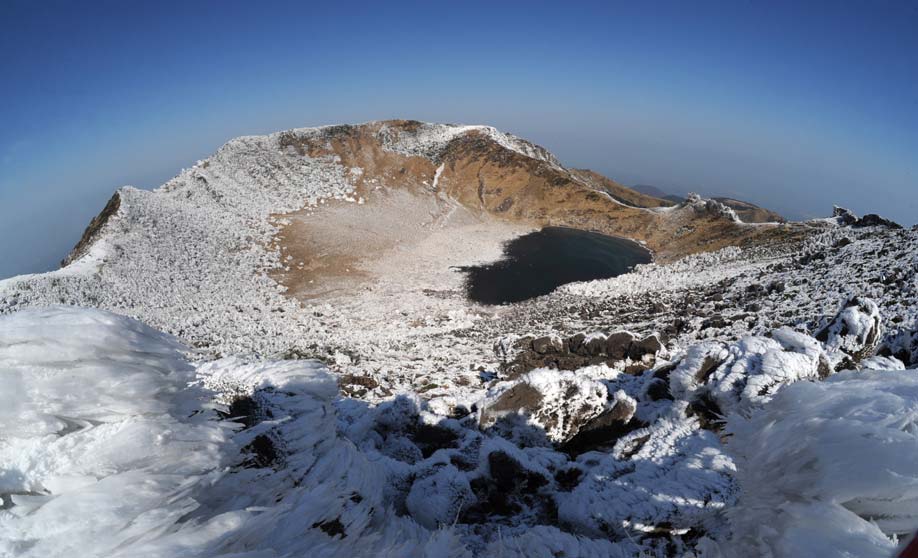 The Geomunoreum lava tube system, which is regarded as the finest such cave system in the world, has an outstanding visual impact even for those experienced with such phenomena. It displays the unique spectacle of multi-coloured carbonate decorations adorning the roofs and floors, and dark-coloured lava walls, partially covered by a mural of carbonate deposits. The fortress-like Seongsan Ilchulbong tuff cone, with its walls rising out of the ocean, is a dramatic landscape feature, and Mount Halla, with its array of textures and colours through the changing seasons, waterfalls, display of multi-shaped rock formations and columnar-jointed cliffs, and the towering summit with its lake-filled crater, further adds to the scenic and aesthetic appeal.
The Geomunoreum lava tube system, which is regarded as the finest such cave system in the world, has an outstanding visual impact even for those experienced with such phenomena. It displays the unique spectacle of multi-coloured carbonate decorations adorning the roofs and floors, and dark-coloured lava walls, partially covered by a mural of carbonate deposits. The fortress-like Seongsan Ilchulbong tuff cone, with its walls rising out of the ocean, is a dramatic landscape feature, and Mount Halla, with its array of textures and colours through the changing seasons, waterfalls, display of multi-shaped rock formations and columnar-jointed cliffs, and the towering summit with its lake-filled crater, further adds to the scenic and aesthetic appeal.
Criterion (x)
Jeju has a distinctive value as one of the few large shield volcanoes in the world built over a hot spot on a stationary continental crust plate. It is distinguished by the Geomunoreum lava tube system, which is the most impressive and significant series of protected lava tube caves in the world and includes a spectacular array of secondary carbonate speleothems (stalactites and other decorations), with an abundance and diversity unknown elsewhere within a lava cave. The Seongsan Ilchulbong tuff cone has exceptional exposures of its structural and sedimentological characteristics, making it a world-class location for understanding Surtseyan-type volcanic eruptions.
Status
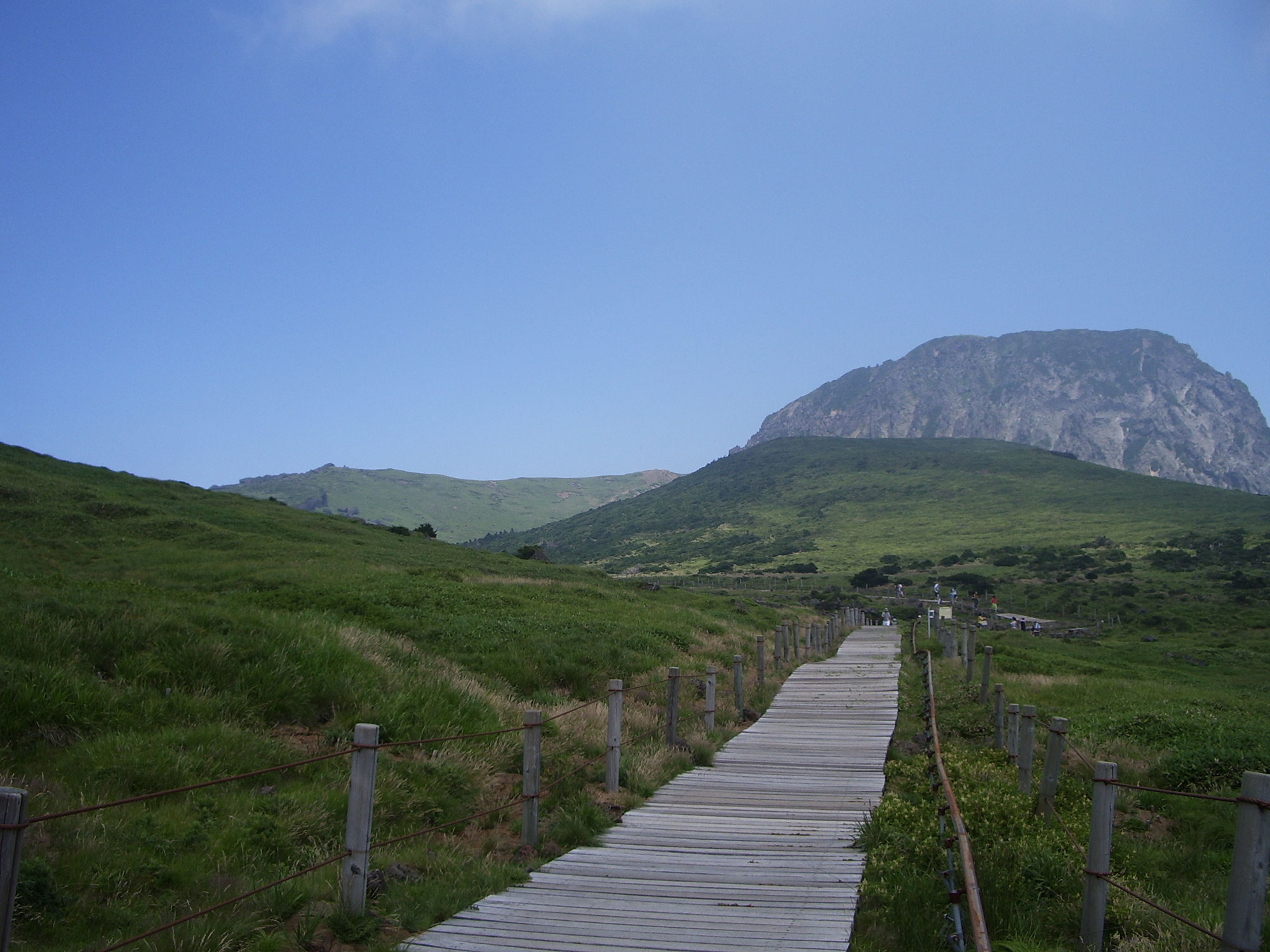 Jeju Volcanic Island and its lava tube systems have a rough geology and topographic features and so have faced minimal threats. It is known that groundwater is practically the sole primary source of freshwater in the island as there are no truly perennial streams (Won et al. 2005). In recent times, there is this issue of overuse of groundwater. The area around the volcanic sites of the island has been experiencing a continuous surge in the human population and urbanization. This has led to an increase in the demand for water for primary activities, mainly, agricultural and urban development (Hagedorn et al. 2011; Won et al. 2006). Agricultural groundwater use has been the most dominant that led to significant decline in the groundwater expense, which ranging from 55.4 to 67%, and increasing annually. The second major groundwater use is for domestic purposes (29.5 to 38.4%) (Choi & Lee 2012). The overuse of freshwater has resulted in saltwater intrusion, particularly in the eastern part of the island (Kim et al. 2003a, b 2006; El-Kadi et al. 2014).
Invasive plant species were introduced to the naturalized plant species pool of Jeju island years ago due to human interference. A study had discovered nine species of invasive alien plants: Lactuca scariola L., Ambrosia artemisiifolia L., Aster pilosus Willd, Hypochaeris radicata L., Solidago altissima L., Rumex acetosella, Solanum carolinense L., Paspalum distichum L. and Paspalum distichum var. indutum (Ryu et al. 2017). Another example is the introduction of red-eared slider turtles (Trachemys scripta elegans) that were previously kept as pets but were released into the natural water system. This made the native juvenile fishes susceptible to undergoing reductions in numbers (Oh et al. 2007). In an overall assessment, the IUCN has reportedly awarded June Volcanic island and its lava tubes the category "good" as the management committee has ensured that there is an efficient and holistic approach to dealing with the high visiting rates and groundwater sustainability. UNESCO mentioned that the property was being managed well with a concrete management plan and adequate resources during the period 2006–2010.
Jeju Volcanic Island and its lava tube systems have a rough geology and topographic features and so have faced minimal threats. It is known that groundwater is practically the sole primary source of freshwater in the island as there are no truly perennial streams (Won et al. 2005). In recent times, there is this issue of overuse of groundwater. The area around the volcanic sites of the island has been experiencing a continuous surge in the human population and urbanization. This has led to an increase in the demand for water for primary activities, mainly, agricultural and urban development (Hagedorn et al. 2011; Won et al. 2006). Agricultural groundwater use has been the most dominant that led to significant decline in the groundwater expense, which ranging from 55.4 to 67%, and increasing annually. The second major groundwater use is for domestic purposes (29.5 to 38.4%) (Choi & Lee 2012). The overuse of freshwater has resulted in saltwater intrusion, particularly in the eastern part of the island (Kim et al. 2003a, b 2006; El-Kadi et al. 2014).
Invasive plant species were introduced to the naturalized plant species pool of Jeju island years ago due to human interference. A study had discovered nine species of invasive alien plants: Lactuca scariola L., Ambrosia artemisiifolia L., Aster pilosus Willd, Hypochaeris radicata L., Solidago altissima L., Rumex acetosella, Solanum carolinense L., Paspalum distichum L. and Paspalum distichum var. indutum (Ryu et al. 2017). Another example is the introduction of red-eared slider turtles (Trachemys scripta elegans) that were previously kept as pets but were released into the natural water system. This made the native juvenile fishes susceptible to undergoing reductions in numbers (Oh et al. 2007). In an overall assessment, the IUCN has reportedly awarded June Volcanic island and its lava tubes the category "good" as the management committee has ensured that there is an efficient and holistic approach to dealing with the high visiting rates and groundwater sustainability. UNESCO mentioned that the property was being managed well with a concrete management plan and adequate resources during the period 2006–2010.
